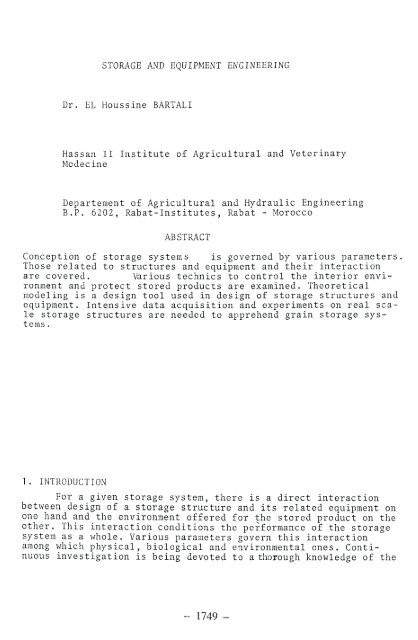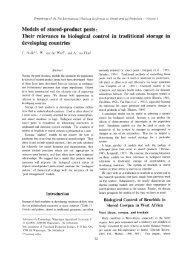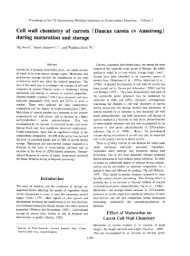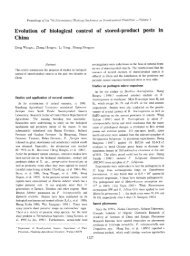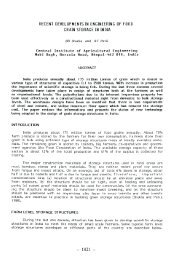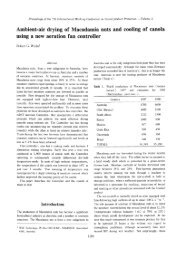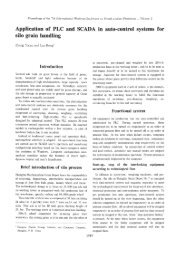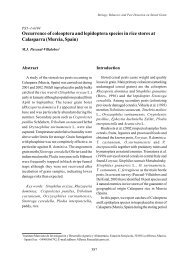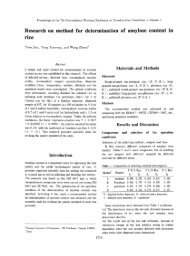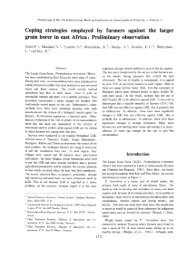Dr. EL Houssine BARTALI - SPIRU Index Page
Dr. EL Houssine BARTALI - SPIRU Index Page
Dr. EL Houssine BARTALI - SPIRU Index Page
You also want an ePaper? Increase the reach of your titles
YUMPU automatically turns print PDFs into web optimized ePapers that Google loves.
Bag storage<br />
Bag storage in warehouses also is practiced and is occasionnaly<br />
combined with bulk storage. This system- requires limited initial<br />
investment compared to real structures. However this system- needs<br />
much more labor for its management and presents some difficulties<br />
for its control. Cheminey systems are made within the grain bulk<br />
using bag in order to allow for air circulation and aeration of<br />
product. This type of storage makes it difficult at acheive grain<br />
treatment against insects. Bags need to be repaired or replaced<br />
for each harvesting campaign. Outdoor sheet covered bag storage<br />
is often practised in order to compensate for shortages in storage<br />
capacities and is usually considered as temporary. The<br />
user then tends to pay insufficient attention for the control of<br />
the stored product leading to some product loss-<br />
Covered bulk storage<br />
Alternative methods for temporary outdoor covered bulk storage have<br />
been developed in countries such as the US, Australia or Europe.<br />
The system components include retaining walls made of corrugated<br />
metal sheets or precast reinforced concrete panels and a cover<br />
sheet.<br />
Such systems present several advantages compared to bag storage<br />
with respect to their cost and efficiency and are being also developed<br />
in other countries. Large storage capacities can be accomodated<br />
using this system.<br />
Underground storage<br />
Underground storage of agricultural products has been practised<br />
for centuries in various places of the world. This system is very<br />
appropriate for on farm storages, Bartali (1987). Investigation<br />
is focused on this alternative storage system- particularly in the<br />
US, Brazil and Morocco. Objectives are to evaluate the advantages<br />
of this system for reduced cost, long term storage, large capacities<br />
and controlled atmosphere. Bartali et al. (1990) investigated<br />
the potential of plastic bags as liners for underground storage<br />
structures. This type of lining tested for barley and wheat storage<br />
has proven very efficient in reducing grain losses as compared<br />
to traditional straw lining. Such improvement will help- rehabilitate<br />
an appropriate low cost and a naturally controlled atmosphere<br />
storage system used for on farm storage.<br />
3. STRUCTURAL DESIGN OF STORAGE STRUCTURES<br />
Several storage structures over the world are made of the two structural<br />
materials, steel and reinforced or prestressed concrete that<br />
can be used alone or combined with each other. Various capacities<br />
can be stored in these storage units but large capacities are often<br />
targeted in order to keep the cost per ton of stored material lower.<br />
The design of such tall structures has to be achieved in order to<br />
meet safety and economy requirements. In the cost repartition, the<br />
structural part of a storage facility can exceed 50 % of the total<br />
cost of the facility.<br />
The system made of stored granular material on one hand and its<br />
holding structure on the other is complex and has its own specificities.<br />
Their mutual interaction has some similarities to a soil-<br />
- 1751 -
through the product. This system is used in clay straw silos and aeration<br />
chimneys in bulk storage. Mechanical 'ventilation is based on<br />
forced circulation of air through the product. More research work<br />
has been accomplished in integrated control of temperature and<br />
relative humidity. This helps increase the management efficiency<br />
of silos.<br />
5. MOD<strong>EL</strong>ING AND ACCURATE DATA ACQUISITION<br />
During the last years, thorough investigation has been devoted<br />
to model storage conditions in order to predict variations of<br />
parameters governing the storage environment and to help the<br />
designer. Hypothesis used as grounds for the simulations are<br />
selected in order to integrate as many parameters as possible<br />
such as heat transfert with internal and external sources, mass<br />
transfer, two or three dimension models.<br />
Intensive effort was also made for accurate data acquisition in<br />
order to achieve a better knOWledge of the storage system- parameters.<br />
Variations of physical parameters such as temperature,<br />
relative humidity of intersticial air, CO 2 and O 2 contents are<br />
covered. The study of real scale experiments has developed.<br />
This helps adress questions that cannot be answered or<br />
extrapolated from lab model experiments. It is to be mentionned<br />
that extensive work has taken place in this field. The Chartres<br />
research facility in France for the investigation of stored products<br />
loads on steel silos, other research facilities in Morocco<br />
and Kansas are worth mentionning.<br />
Numerical Modeling applied to aeration and fumigation of stored<br />
grain has been examined by Wilson (1990) in the perspective of<br />
providing the user with a tool for sizing and evaluating the<br />
performance of grain-store ducts. The PC program developed predicts<br />
velocity, pressure, flow uniformity and fan pressure load<br />
and can be used for horizontal or vertical grain stores with various<br />
ducts layout.<br />
Dzisi et al. (1990) have developed a two dimensional computer model<br />
to simulate the heat transfer in a sheeted bagstack of maize.<br />
The model that has been validated showed many similarities with<br />
observed temperature distribution data obtained from a storage<br />
experiment run in Ghana. The model predictions fairly compared<br />
'vith actual data from a warehouse in Ghana.<br />
- 1754 -
ROTH et KH<strong>EL</strong>IL (1990) : Etude du comportement des parois de silos<br />
de stockage sous l'action de la matiere ensilee. 5th International<br />
Working Conference on Stored Product Protection. September 9-14<br />
1990, Bordeaux France.<br />
SHUKLA (1990) : Recents development in engineering of food grain<br />
storage in India. 5th International Working Conference on Stored<br />
Product Protection. September 9-14, 1990, Bordeaux France.<br />
WILSON (1990) :Duct : A PC program for sizing and evaluating the<br />
performance of grain store ducts. 5th Intern-tional Working Conference<br />
on Stored Product Protection. September 9-14, 1990,<br />
Bordeaux France.<br />
EVALUATION DES POTENTIALITES DU STOCKAGE SOUTERRAIN DES<br />
CEREALES<br />
<strong>Dr</strong>. <strong>Houssine</strong> <strong>BARTALI</strong><br />
Institut Agronomique et Veterinaire Hassan II<br />
B. P. 6202, Rabat-Instituts<br />
Resume<br />
Le stockage souterrain des cereales et autres denrees agricoles est un<br />
technique connue de longue date dans plusieurs regions du monde. Vne evaluation<br />
de ce systeme de stockage a ete entreprise dans Ie cadre des travaux de recherche <br />
developpement de l'Institut Agronomique et Veterinaire Hassan II de Rabat avec un<br />
support financier du Science Advisor Council de l'AID Washington.<br />
L'experience menee a couvert Ie stockage de l'orge et du ble dur dans des<br />
entrepets souterrains de 15 quintaux de capacite chacun. Vne analyse approfondie<br />
des parametres physiques de stockage temperature, humidite relative de l'air<br />
interstitiel et de la teneur en C02 dans les entrepets souterrains Ii revetement<br />
interne en paille ou en plastique a ete operee. Vne analyse parallele des echantillons<br />
de produits stockes preleves aux niveaux des capteurs de temperature a ete realisee<br />
par une €!quipe pluridisciplinaire de chercheurs travaillant sur les denrees stockees.<br />
Cette recherche qui s'est deroulee sur une periode de 16 mois pour Ie stockage du ble<br />
dur et de 6 mois pour celui de l'orge, a mis en evidence Ie role du revetement<br />
plastique etanche des parois d'entrepets souterrains. En effet, les taux des pertes ont<br />
ete roouits grace au revetement plastique de pres de 20 % par rapport aux niveaux<br />
qu'ils atteignaient avec un revetement paille classiquement utilise par les<br />
agriculteurs.<br />
- 1756 -


